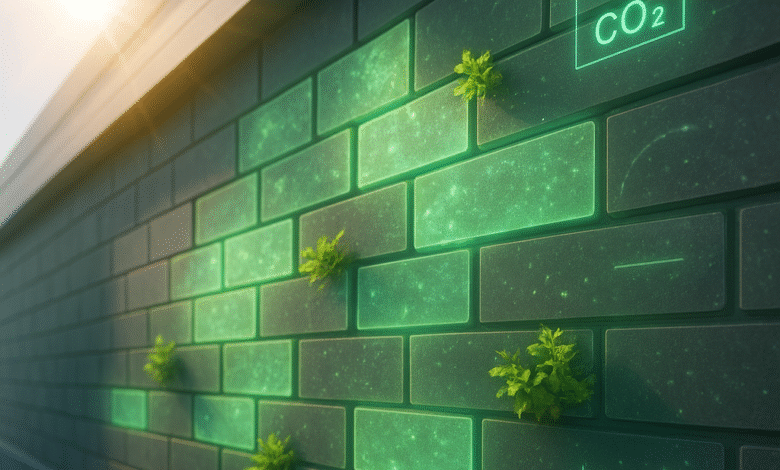Living Bricks: Building a Greener Future with Carbon-Absorbing Materials

In the world of construction, the brick has always symbolized permanence. From ancient forts to modern skyscrapers, bricks have formed the backbone of human civilization. But what if the humble brick could do more than just hold up walls? What if it could breathe, grow, and even help fight climate change?
That’s no longer a fantasy. Around the world, scientists are experimenting with “living bricks”—construction materials embedded with microbes that can absorb carbon dioxide from the atmosphere, self-heal cracks, and even multiply. These revolutionary building blocks are poised to change how we think about both construction and sustainability.

The Problem with Conventional Bricks
Traditional bricks may look harmless, but they come with a heavy carbon footprint. The brick-making process, especially firing clay bricks, releases enormous amounts of CO₂. According to estimates, construction materials account for around 11% of global CO₂ emissions. As cities grow and urbanization accelerates, finding alternatives has become urgent.
That’s where living bricks enter the scene: instead of emitting carbon, they capture it.
Bricks that Are Alive
In 2020, researchers at the University of Colorado Boulder unveiled a groundbreaking material: a brick infused with cyanobacteria—microbes that use photosynthesis to absorb CO₂ and release oxygen. These bacteria were mixed with sand and gelatin to create a living scaffold. The result: a green-hued brick that actually grew and hardened over time.
Unlike conventional bricks, which are dead and static, these living bricks had the ability to regenerate. If you split one in half under the right conditions, the bacteria inside could grow into two new bricks. Essentially, a building could grow its own materials on-site, dramatically cutting down on manufacturing emissions and transport costs.
Beyond Carbon Capture
The potential of living bricks doesn’t stop at absorbing carbon dioxide. Scientists envision multifunctional building blocks that could:
- Self-heal: Microbes inside the bricks could fill in cracks with minerals like calcium carbonate, extending building lifespans.
- Filter pollutants: Engineered bacteria could neutralize harmful chemicals in the air or water that passes through building walls.
- Adapt environments: Some designs may allow bricks to change color or transparency depending on light, offering natural cooling benefits.
- Act as mini power stations: With bioengineered organisms, bricks might one day generate electricity by harvesting biochemical reactions.
Such possibilities could radically transform urban infrastructure, turning buildings into living, breathing systems rather than static energy drains.
Other Innovations in Bio-Bricks
The concept isn’t limited to Colorado. Around the globe, labs are experimenting with different approaches to carbon-absorbing bricks:
- BioMASON, a U.S. startup, uses bacteria to “grow” bricks at room temperature by precipitating calcium carbonate, mimicking the way coral reefs form. Their process avoids firing kilns altogether, drastically reducing emissions.
- Researchers in the UK have developed magnesium-based bricks that not only avoid CO₂ emissions but actively absorb carbon during the curing process.
- Experiments in the Netherlands and Singapore are exploring algae-based facades that work like vertical forests, capturing CO₂ and producing oxygen directly from building exteriors.
Each of these innovations adds momentum to the vision of buildings that aren’t just carbon-neutral, but carbon-negative.
Challenges on the Road
As exciting as this sounds, living bricks still face significant hurdles before they can go mainstream:
- Durability: Living organisms are sensitive to environmental conditions like temperature and moisture. Scientists must ensure these bricks remain strong and functional in varied climates.
- Safety and Regulation: Embedding living organisms in construction raises questions about long-term stability and public safety. Regulations for “living architecture” are still in their infancy.
- Scalability: Producing bricks in labs is one thing; manufacturing millions for global cities is another. Scaling up the process while keeping costs competitive will be crucial.
Despite these obstacles, optimism runs high. Every major shift in construction—whether reinforced concrete or steel frames—once faced similar skepticism.
The Future of Living Architecture
Imagine walking into a city decades from now. Towers rise above you, their walls alive with carbon-absorbing bricks that filter the air. Homes generate some of their own power through microbial processes. Cracks in the walls heal themselves. Even better, the materials for these buildings weren’t fired in carbon-spewing kilns—they were grown, nurtured like crops.
This is the promise of living bricks: cities that act more like ecosystems than machines, actively participating in the fight against climate change.
As the climate crisis accelerates, bold innovation is not a luxury but a necessity. If the brick helped build civilization once, perhaps a living brick can help save it.
References
- University of Colorado Boulder – Cyanobacteria-based living bricks research (2020).
- BioMASON’s bio-cement bricks produced through microbial processes.





